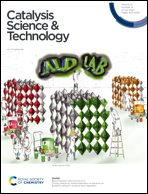Effect of Cu and Sb active sites on the acid–base properties and reactivity of hydrated alumina for glycerol conversion by dehydrogenation and dehydration reactions†
Abstract
Bifunctional Cu–Sb containing catalysts supported on hydrated alumina prepared by different methods were evaluated for glycerol dehydrogenation and dehydration in the gas phase. The catalyst characterization data reveal the effect of the synthesis method on the Cu and Sb dispersion, reducibility, and textural and acid–base properties, leading to different catalytic performances. Adding Cu and Sb metals changes the acid–base properties of hydrated alumina (bayerite), such as the sites' strength, number and type, according to the CO2-TPD profile and pyridine adsorption isotherm. Density functional theory (DFT) calculations of CO2 and pyridine adsorption point to the energetically more favourable adsorption on the Cu–Sb bridge site with electron transfer from Cu and Sb atoms on the surface to the molecule. Experimental data show that the CuSbAl catalysts prepared by the polymeric precursor method with well-dispersed Cu redox species and balanced acid–base sites achieved the highest catalytic activity for the glycerol conversion to acetol. A possible reaction pathway is proposed with the Cu metal providing an active redox site for glycerol dehydrogenation and dehydration with consecutive hydrogen transfer to form acetol. The combination of experimental and theoretical results shows that the glycerol dehydrogenation into glyceraldehyde intermediate should be the more thermodynamically favourable route for the acetol formation over the CuSbAl catalyst.



 Please wait while we load your content...
Please wait while we load your content...